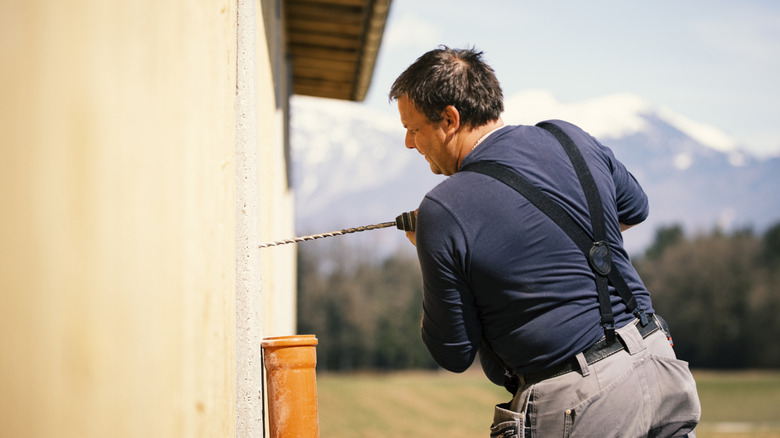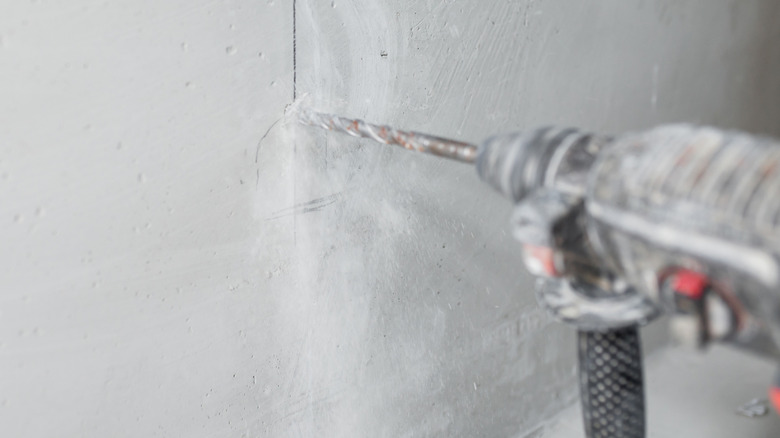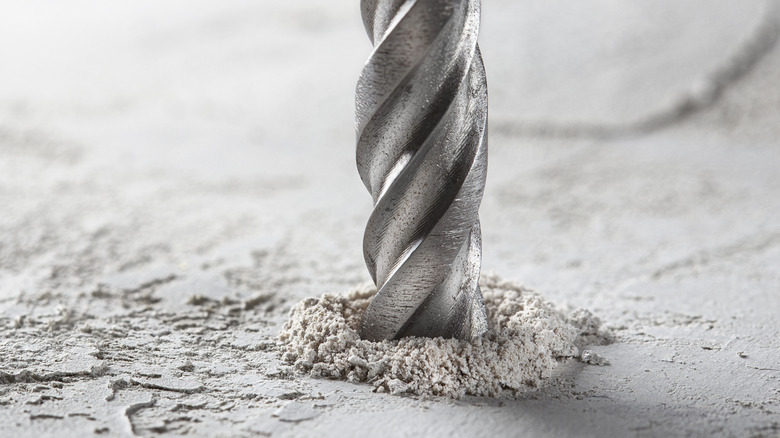How To Drill Into Concrete Using Regular Tools You Already Own
DIYers want to get things done, and they want to get them done now. Their strategy for this isn't comparing contractor bids or spending half the day in a Lowe's line behind someone arguing over the price of potted plants. No, their strategy for getting things done is to do them. Sometimes that means working with what you have to do things you haven't, like drilling into concrete.
You could take it on with your regular drill, or you could drive to your big box hardware store and buy a hammer drill to do the work for you. We won't judge which one is smarter, but the former is certainly more epic. Nobody writes songs about John Henry because he went to Menard's and bought a steam drill. The steel-drivin' man took up his tools and tunneled 15 feet, while the steam drill only made nine. Of course, you should probably be prepared for the fact that using the tools you have — a corded drill, perhaps, and maybe even a couple of standard twist bits — will be slower than a hammer drill and specialty concrete bits. But, unless you have a lot of holes to drill, it probably won't take as long as stopping work and heading to Harbor Freight.
Just remember that the human spirit might be indomitable, but the body is not. John Henry beat the steam drill, but he died in the process. Safety precautions always come first; keep your weight on your feet, not the drill, and use your safety gear. A dust mask, gloves, and eye protection are crucial when you're drilling concrete, especially the hard way.
Born with a hammer (drill) in his hand
If you don't have a steam drill — or a hammer drill or rotary hammer, the power drills usually recommended for boring into concrete — at least you're not reduced to using a hammer like John Henry. Though many sources will tell you that an impact driver isn't a good choice for drilling into concrete, a good impact driver will often do the job more effectively than a poor quality hammer drill. But you might not have an impact driver, and even if you do, they require a bit with a ¼-inch hex shank, so there's a good chance you'll consider using a regular drill. And that's actually okay, though it will probably take around twice as much time and a bit more physical effort to get the job done. If you have the option, use a corded drill rather than a battery-operated model; the work is demanding, and you might burn through an entire battery charge drilling one hole, while a more powerful corded drill would do the work faster.
The only difference in the processes of using a hammer drill or a regular drill is that you might have to apply more force to the regular drill to get it to bite into the concrete. The need for more active participation is exactly why you should turn off the hammer function on a hammer drill when starting a hole in concrete; you will do it more carefully and precisely because of the effort required, and it's less likely to get ahead of you. The force will make things turn dangerous fast if a bit breaks or slips.
The drill bits and the damage done
A bigger concern is your selection of drill bits. You might get away with drilling into concrete with your wood or metal drill bits, but you shouldn't try. Bits made for drilling masonry and concrete are widely available and reasonably priced; the average price of Lowe's top-selling, in-stock masonry bits (55 total) is currently $6.47. Standard bits will wear quickly and can overheat and fail altogether. That usually means breaking off in the hole you're drilling, which could send you sprawling with a jagged bit in a running power tool, and will at a minimum mean that you now have a permanently embedded drill bit where you wanted a hole.
By contrast, masonry bits (and specialized bits specifically intended for use on concrete) are designed to handle the hardness of cured concrete and the pressure and heat you generate along the way. They're shaped specifically to easily penetrate concrete, and can usually even cut through concrete reinforcements like rebar. Given the risk of tool destruction and injury, stick with masonry bits when working with concrete or even drilling a hole in mortar or driving a screw into stone.
With any drill, the process is mostly the same: Start slowly and speed up as your hole is properly sited. If you're aiming for a large-diameter hole, start with a small bit and work your way up slowly. Don't force the drill if you can avoid it. Use a wide stance and direct any force straight along the bit's shaft. And don't forget to blow or vacuum out your hole to get rid of concrete dust that might interfere with your fastener.


